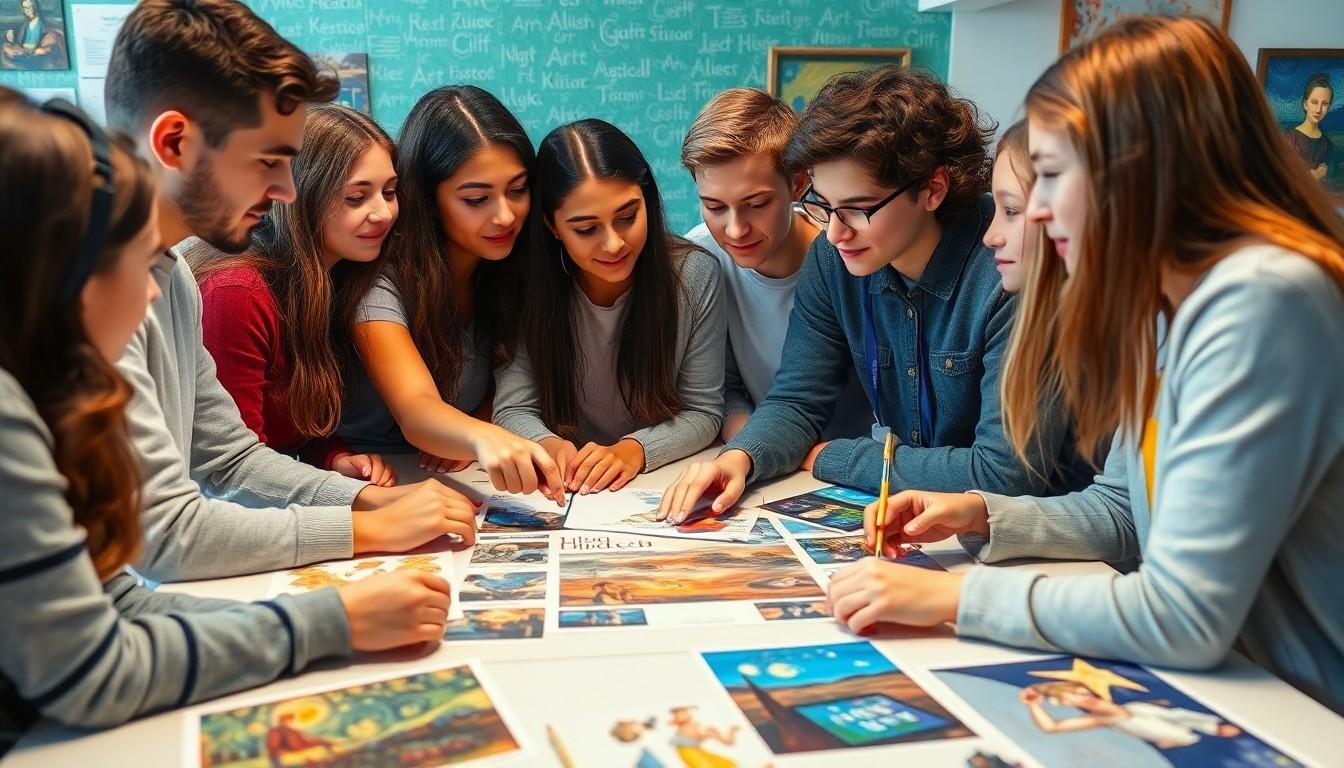Navigating the world of art history can feel like trying to decipher a Picasso while blindfolded. But fear not! This AP Art History study guide is here to turn that confusion into clarity. With a dash of humor and a sprinkle of expertise, it’ll help students tackle everything from ancient sculptures to modern masterpieces without losing their minds—or their coffee.
AP Art History Study Guide
AP Art History prepares students for the depth and breadth of art’s evolution. The course encourages critical thinking and analysis of various artistic movements and periods.
Purpose of the Study Guide
This study guide aims to demystify AP Art History, offering organized resources for review. Coverage includes major art movements, influential artists, and key works across history. Students gain familiarity with the context and significance of artworks, enhancing their ability to discuss and write about art. By structuring content around essential themes, the guide promotes efficient study habits and deeper comprehension.
Structure of the AP Art History Exam
The AP Art History exam consists of two sections: multiple-choice and free-response. The multiple-choice section includes 80 questions covering various artworks, artists, and themes across cultures and time periods. Free-response tasks require students to analyze and discuss specific artworks, demonstrating their understanding. Each part assesses students’ knowledge, critical thinking, and interpretative skills, creating a comprehensive evaluation of their abilities in art history.
Key Art Movements

Understanding key art movements helps students grasp the evolution of artistic expression. Each movement reflects cultural, social, and technological changes over time.
Prehistoric Art
Prehistoric art includes cave paintings, petroglyphs, and figurines. These artworks often represent hunting scenes and fertility symbols. The Lascaux cave paintings in France exemplify early human creativity, dating back to approximately 15,000 BCE. Stone carvings and sculptures, like the Venus of Willendorf, highlight humanity’s connection to fertility and survival. These artifacts offer insight into the lives and beliefs of early prehistoric communities.
Ancient Civilizations
Ancient civilizations produced diverse art forms, from Egyptian hieroglyphs to Greek sculptures. The pyramids of Giza showcase architectural prowess and spiritual significance. Greek pottery often depicted mythological stories, revealing cultural values and beliefs. Roman art emphasized realism and portraits, showcasing individualism and status. Each civilization contributed to the understanding of human experience through art.
Renaissance and Baroque
Renaissance art marks a rebirth of classical themes and humanism. Artists like Leonardo da Vinci transformed perspective and anatomy, exemplified in works such as the “Mona Lisa.” Baroque art follows with dramatic contrasts and emotional intensity. Caravaggio’s use of light and shadow captivates viewers, conveying deeper narratives. Both movements celebrate innovation, emotion, and the exploration of human experience.
Modern and Contemporary Art
Modern art emerged in the late 19th century, rejecting traditional styles. Movements like Impressionism, led by artists such as Monet, focus on light and color to capture fleeting moments. Contemporary art challenges conventions, incorporating diverse media and themes. Artists like Damien Hirst explore the relationship between art and society. Each period reflects innovation, experimentation, and societal commentary through its distinctive visual language.
Important Artists and Their Works
Students looking to excel in AP Art History should familiarize themselves with significant artists and their impactful works. Understanding these connections helps in grasping broader art movements and themes.
Notable Artists to Study
Leonardo da Vinci exemplifies Renaissance innovation with works like the “Mona Lisa” and “The Last Supper.” Vincent van Gogh’s post-impressionism shines through “Starry Night,” revealing emotion and color intensity. Pablo Picasso, pivotal in the development of Cubism, produced “Les Demoiselles d’Avignon,” which challenges traditional perspectives. Frida Kahlo’s self-portraits explore identity and pain, notably in “The Two Fridas.” Finally, Andy Warhol’s pop art, highlighted by “Campbell’s Soup Cans,” transforms everyday objects into cultural commentary.
Analyzing Key Artworks
Artworks often reflect historical and cultural contexts. The “Mona Lisa” portrays enigmatic beauty, inviting inquiries into artistic technique and societal values. “Starry Night” captures van Gogh’s psychological state, characterized by swirling colors and bold strokes. “Les Demoiselles d’Avignon” deconstructs traditional composition, prompting discussions about form and perspective. Kahlo’s “The Two Fridas” engages with themes of duality and identity, while Warhol’s “Campbell’s Soup Cans” critiques consumerism in modern society. Each piece serves as a gateway to deeper understanding of its era’s artistic language and meanings.
Study Strategies for AP Art History
Effective study strategies enhance understanding and retention in AP Art History. Students benefit from engaging with the material in various ways.
Effective Study Techniques
Balance reading assignments with active learning. Incorporate flashcards to memorize key terms and artists. Explore visual aids, such as timelines and charts, to connect art movements chronologically. Engage in group discussions to gain different perspectives and clarify complex concepts. Practice writing free-response questions to familiarize with exam expectations. Regularly review class notes to reinforce knowledge of specific artworks and artists. Utilize thematic essays to synthesize information across different periods.
Recommended Resources
Utilize online platforms like Khan Academy, offering structured lessons on art history. Consult AP Art History textbooks for in-depth analysis of artworks and movements. Investigate museum websites, which often provide virtual tours and collections. Access video lectures from established art historians to enhance learning. Consider joining online forums for peer support and resource sharing. Review past exam questions available through the College Board to assess readiness. Leverage high-quality documentaries to visualize artworks and contextualize their historical significance.
Practice and Review Materials
Accessing practice and review materials proves essential for mastering AP Art History. These resources help students solidify their understanding of concepts and key artworks.
Sample Questions and Themes
Engaging with sample questions brings clarity to exam expectations. Students encounter questions focused on major art movements and influential artists. Themes often encompass the impact of cultural contexts on artistic expressions. Analyzing past exam questions reveals patterns and critical focus areas. The College Board provides official practice questions, which mimic the exam format. Reviewing multiple-choice and free-response prompts enhances familiarity with key themes, fostering effective responses in the actual exam environment.
Creating Flashcards and Study Aids
Developing flashcards serves as a powerful memorization technique. First, students create cards for key terms, influential artists, and significant artworks. Next, engaging with visuals on flashcards promotes connection between art and context. Utilizing study aids like timelines helps students visualize movements chronologically. Group study sessions provide opportunities for discussion and clarification of concepts. Incorporating multimedia resources, such as online quizzes, complements traditional study methods. Making these study aids encourages active learning and strengthens retention of essential information.
Effective Study Strategies
Mastering AP Art History requires dedication and effective study strategies. By utilizing the resources and techniques outlined in the guide, students can confidently navigate the complexities of art movements and influential artists. Engaging with practice materials and fostering active learning will deepen their understanding and retention of essential concepts.
As they prepare for the exam, students should embrace the rich tapestry of art history, appreciating how each work reflects its cultural and historical context. With the right approach, they’ll not only excel in their studies but also cultivate a lasting appreciation for the world of art.

